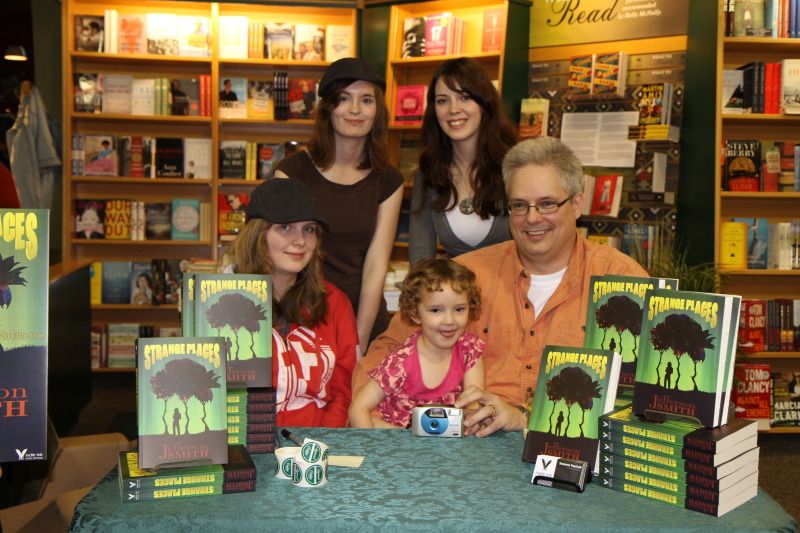 Writing Time is Family Time
Writing Time is Family TimeLike many authors I have spoken to, my writing time had always been a fairly isolating and lonely process. Was it any wonder that, in that environment, I had somehow managed to get all tangled up in myself? In a sense, my early stories had felt like me, talking to me, about me. No wonder they seemed dull and lifeless. But then one day a funny thing happened: I started working with my daughter. At first, it was just an idea we had for a character. She was interested in all things Goth at the time, and I was looking for a way to get her to express herself, so we put our heads together and came up with a girl character named Tayna. At the time, Tayna was a bit darker and broodier than she is now, but she already had the competence and the "nobody's fool" things going on. And she definitely had the funny. The core of our favorite orphan was already in place.
I then spent a pile of time trying to interest my daughter in maybe writing stories about this quirky Tayna girl. "I think she lives in an orphanage," I said to her one morning, trying to find a way to spark her interest. "And she has a bit of magic, too - but nothing obvious. Like, maybe she's uncommonly good with plants." We did this dance for an entire school year, me coming up with detail after detail, trying to find something that would fascinate an 12-year-old girl, and that part worked - she was definitely interested - but my daughter never really clicked with the idea of writing anything herself.
Eventually, I realized that she never would, and that if Tayna was ever going to come to life, it would be up to me to breathe that life into her. This is when I first noticed just how much material I had to work with. We had worked out Tayna's home life, back story, physical sketches, maps, an army of supporting characters... even an entire musical score. (Although that's a subject for another article.) The point is, I had everything I needed. All that was left to do was develop it into a manuscript.
So I did. I began on January 1, 2007, and the story just poured out of me. It was as though this world was already fully formed in my head, and all I had to do was type. Each week or two I produced another chapter and by the end of February I had four or five of them ready, and the more I wrote, the more enthusiastic I became.
But was it any good?
I had always been a fan of young adult fantasy - which is what I was writing - but I had seen far too many examples that didn't seem to me like they would be interesting to teen readers. Often, the characters I'd encountered in YA books felt timid or sheltered. They didn't feel like the teens I knew, who spoke with attitude and acted impulsively, with passion and urgency. When I was a teen, I can remember ideas being born, exploding in my head with all the energy of a bomb burst, compelling me to jump up and do something about it. Right here. Right now. Opportunities had to be seized before somebody else saw them. Injustices had to be squashed in the instant they were recognized. That was the kind of teen I wanted to write about, but had I captured that feeling with Tayna? And if I had, would today's teens relate to her as I hoped?
So that started my weekly readings. Each Sunday after dinner, I gathered the family in the living room and read them a chapter. I tried to read with all the vitality and excitement that I had been hearing in my head as I wrote. Sister Regalia's imperious decrees and her treacherous chuckle. Disturbing prattle from the homeless Duck Man and boisterous delight from Abeni, the enormous Djin adventurer.
To my utter amazement, the kids ate it up. Each chapter ended on a cliff hanger, and soon I had them glued to their seats every Sunday, and between Sundays I was peppered with questions.
"What are the nuns going to do to her now?"
"Is Tayna really going to get adopted?"
"Why is the Duck Man following her?"
"Did she really run away? Who's going to take care of her?"
Each week, the chapters got more exciting, because now I had an audience. In between readings, I kept going back to tweak the details, ratcheting up the suspense, tantalizing just a little more with teases of information. It was like a dance - me leading with story and my girls following closely along, responding with their teen-aged boredoms and enthusiasms as the story delighted them or did not. When it didn't, I knew that I had to go back and do it again.
 In the end, it took two years. Not because the writing took that long, but because I was a dad with a lot of other responsibilities. I did volunteer work, I was working toward a Ph.D. There were bills to pay, soccer games to drive to, and vacations to take. But as it happens, I finished the manuscript exactly two years after I began, on January 1, 2009. By that time, I had not only tested it with my own girls, but my readings had expanded to include some of their friends from school as well. I even went into classrooms around our city and engaged entire classes of kids on critiquing particular sections, or getting feedback about different characters, or conversations. We were educating each other. One class convinced me that an entire new sub-plot was needed, to help spice up a slow section. Another class even convinced my publisher to change the cover design, but I'm getting ahead of myself.
In the end, it took two years. Not because the writing took that long, but because I was a dad with a lot of other responsibilities. I did volunteer work, I was working toward a Ph.D. There were bills to pay, soccer games to drive to, and vacations to take. But as it happens, I finished the manuscript exactly two years after I began, on January 1, 2009. By that time, I had not only tested it with my own girls, but my readings had expanded to include some of their friends from school as well. I even went into classrooms around our city and engaged entire classes of kids on critiquing particular sections, or getting feedback about different characters, or conversations. We were educating each other. One class convinced me that an entire new sub-plot was needed, to help spice up a slow section. Another class even convinced my publisher to change the cover design, but I'm getting ahead of myself.With the manuscript completed, it was time to start looking for that publisher, and the whole family pitched in. One daughter helped with mailing and tracking query letters, another helped create post cards for a proposed marketing campaign. But the manuscript was a bit long: 116,000 words. And our story had somehow morphed into a series: Finding Tayna. Would a publisher really want to commit to three books from an unknown author? What if fans didn't like it? The rejection letters from publishers came in, one by one, and although I kept telling the kids that it only takes a single yes, I could tell that they were getting depressed. Nobody would ever fall in love with this spunky little teen that we had all been living with for so long.
But then, as if by magic, it happened. Through a complete fluke, I was introduced by a friend to a publisher who was interested in my technology background. She didn't even know at the time that I had a manuscript in circulation. We talked tech for a while, and then I asked her to read Strange Places. When she came back, I could tell that our relationship had changed. Apparently, my attempts to channel the experiences of children waiting for adoption had been more universal than I had expected, because unbeknownst to me, my publisher had herself been an adopted child and something in Tayna's experience had spoken to her. She related to our spunky little orphan girl. As suddenly as that, we had our publisher.
The thing they don't tell you in the dream academy where life ambitions are born though, is that being a writer gets busier after you find a publisher, not less busy. It wasn't just the edits and the rewrites and the proofs and cover designs and all of that. We also had to plan a launch campaign. This had always been a family project, and kids all across the city had joined that extended family, helping with the writing and honing of Tayna and her story. Now I was supposed to stand at a podium and take all the credit? Not a chance. For our launch, we wanted something big. Something inclusive. Something that involved as many of the kids who had helped as possible.
Which is when the creativity really started to flow.
Two of my daughters wrote a song about Tayna and her orphan friends - a haunting, beautiful song. Then another daughter filmed a music video for that song, dramatizing the orphanage and the cruel existance faced by Tayna's stalwart little crew of adoption wannabes. I worked with another fan to come up with an actual recipe for boh-cho - the high energy travelers' drink prefered by Djin everywhere. We drafted a teacher or two and half a dozen classmates to do a dramatic reading of the first scene of the book. The song-writing girls worked out a way to perform the song live. We created a contest, where fans could solve a riddle of clues for a chance to be written into the next book as a major character. We made post-cards and puzzles and book marks to hand out. Everything we did for the launch involved either my own daughters, or the boys and girls of Saskatoon who had helped us refine the story. When launch day finally came, we really put on a show: songs, dramatic readings, tasting samples, games. It was as though, for those two fleeting hours, the entire city was made up of my kids and my extended kids. We had a blast, and the people who came out to the launch had a blast, too.
Since then, I have become very involved in the local schools, working with creative writing classes, art classes, music classes - the whole works. I even do Skype visits to classes and book clubs all over Canada. And when I work with schools, I like to point out that every subject has something to learn from a creative collaboration with artists, just as I have something to learn from every kid I work with, in every subject. These days, when I'm writing, I have a thousand kids I can call on for feedback. Whether it's the few who live in my house, or the many scattered throughout the schools of Saskatchewan, or the ones who follow me on Facebook or Twitter. I'm constantly reaching out, asking questions, seeking advice. Just this week I asked fans on FB to suggest names for some minor characters I'm putting into Book 2, and I got some great suggestions that I have already written into the draft. So as you can see, writing has stopped being a lonely and isolating process for me.
It's become a family thing.
Thank you, Jefferson, for such an awesome post! Be sure to check out Jefferson's website and Strange Places which was released in June 2011.









0 comments:
Post a Comment